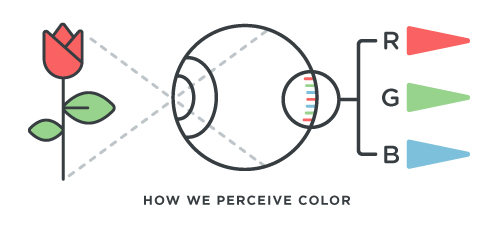Color Blindness 101
Posted Mar 31, 2020 | Eye Health
When a person is colorblind, what does this mean? Do they see in black and white? Well, not typically (but that’s possible, too!). Research shows that 1 in 5 men are colorblind, while 1 in 200 women are colorblind. But what is the difference between this and normal color vision?
Keep reading to learn more about what it means to have a color vision deficiency, what causes color blindness, and what colorblind people see.
What is color blindness?
Color blindness, also known as color deficiency (or daltonism), is when a person is unable to easily distinguish between certain colors (red-green is the most common), unlike individuals with full color vision. The cones in your eyes contain pigments that allow you to see all colors. When there are missing or displaced pigments, this may cause color vision deficiencies.What causes color blindness?
Color blindness is most commonly genetic and can develop either at birth or later in life. When a person sees light and color, the light-receptive cells in the retina either respond, or don’t—at least in a typical way. The cones in our eyes sense wavelengths in order to differentiate between colors. When a person is colorblind, they have a different sensitivity in their cone cells than a person with normal color vision, and therefore cannot tell the difference between certain colors.Other factors that can contribute to color blindness include age, cataracts, or damage to parts of the eyes, optic nerve or brain.

How do I know if I’m colorblind?
In order to find out if you have a color deficiency, you should see your eye doctor. You could also take a colorblind test, but professional advice is always recommended! There are color tests such as an Ishihara test (red-green color test) among others. These tests can detect color vision deficiencies by arranging shapes, letters, or numbers using dots in colors that would be difficult for a colorblind person to distinguish between.How many people are colorblind? Why are men more likely to be colorblind than women?
It is estimated that 300 million people are colorblind worldwide. 95% of those people are men. Men are more likely to be color blind because it is, in most cases, inherited on the X chromosome; men only have one of these chromosomes while women have two! This means that men are twice as likely to have a color deficiency. Even if a woman has an X chromosome with a colorblind gene, another X chromosome without the gene will cancel out the former.What do colorblind people see? 4 types of color blindness
There are 4 main types of color blindness; these range between red-green color blindness, blue color blindness, and monochromatic color blindness.
- Deutan is the most common color blindness. It causes an issue with distinguishing between green colors—it’s also known as green-weak or green-blind. Deuteranopia is when a person is missing their green cone cells and deuteranomaly is when the green cones are displaced.
- Protan causes a color deficiency of red colors—it’s also known as red-weak or red-blind. Protanopia is when a person is missing their red cone cells and protanomaly is the displacement of red cones.
- Tritan, like the other forms, affects particular color cone cells. People with tritanopia are missing blue cone cells and those with tritanomaly have displaced blue cone cells. With tritan, yellow color blindness is also possible, as people have a hard time differentiating between yellow and violet hues.
- Achromatopsia, or rod monochromacy, is when a person does not have color vision at all because they are missing photopigments in their cones entirely.

Did you know?
- Dogs do see color, but much like someone who has red-green color blindness.
- Though rare, it’s possible to be color blind in only one eye; this is called unilateral dichromacy.
Want more to read?
Find more stories on the Eyeconic Blog! Eyeconic BlogSOURCES
https://www.vspdirect.com/vision-hub/four-facts-about-color-blindnesshttp://www.colourblindawareness.org/colour-blindness/
https://enchroma.com/blogs/beyond-color/interesting-facts-about-color-blindness